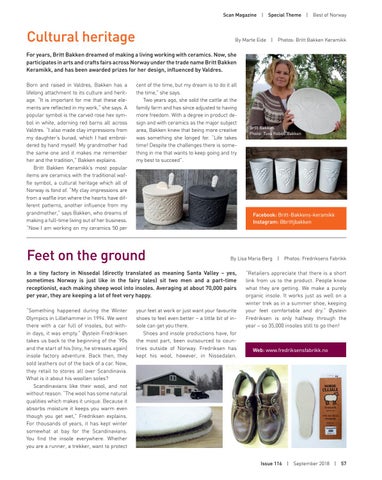Scan Magazine | Special Theme | Best of Norway
Cultural heritage
By Marte Eide | Photos: Britt Bakken Keramikk
For years, Britt Bakken dreamed of making a living working with ceramics. Now, she participates in arts and crafts fairs across Norway under the trade name Britt Bakken Keramikk, and has been awarded prizes for her design, influenced by Valdres. Born and raised in Valdres, Bakken has a lifelong attachment to its culture and heritage. “It is important for me that these elements are reflected in my work,” she says. A popular symbol is the carved rose hex symbol in white, adorning red barns all across Valdres. “I also made clay impressions from my daughter’s bunad, which I had embroidered by hand myself. My grandmother had the same one and it makes me remember her and the tradition,” Bakken explains. Britt Bakken Keramikk’s most popular items are ceramics with the traditional waffle symbol, a cultural heritage which all of Norway is fond of. “My clay impressions are from a waffle iron where the hearts have different patterns, another influence from my grandmother,” says Bakken, who dreams of making a full-time living out of her business. “Now I am working on my ceramics 50 per
cent of the time, but my dream is to do it all the time,” she says. Two years ago, she sold the cattle at the family farm and has since adjusted to having more freedom. With a degree in product design and with ceramics as the major subject area, Bakken knew that being more creative was something she longed for. “Life takes time! Despite the challenges there is something in me that wants to keep going and try my best to succeed”.
Facebook: Britt-Bakkens-keramikk Instagram: @brittjbakken
Feet on the ground
By Lisa Maria Berg | Photos: Fredriksens Fabrikk
In a tiny factory in Nissedal (directly translated as meaning Santa Valley − yes, sometimes Norway is just like in the fairy tales) sit two men and a part-time receptionist, each making sheep wool into insoles. Averaging at about 70,000 pairs per year, they are keeping a lot of feet very happy. “Something happened during the Winter Olympics in Lillehammer in 1994. We went there with a car full of insoles, but within days, it was empty.” Øystein Fredriksen takes us back to the beginning of the ‘90s and the start of his (tiny, he stresses again) insole factory adventure. Back then, they sold leathers out of the back of a car. Now, they retail to stores all over Scandinavia. What is it about his woollen soles? Scandinavians like their wool, and not without reason. “The wool has some natural qualities which makes it unique. Because it absorbs moisture it keeps you warm even though you get wet,” Fredriksen explains. For thousands of years, it has kept winter somewhat at bay for the Scandinavians. You find the insole everywhere. Whether you are a runner, a trekker, want to protect
Britt Bakken. Photo: Tuva Reboli Bakken
your feet at work or just want your favourite shoes to feel even better − a little bit of insole can get you there. Shoes and insole productions have, for the most part, been outsourced to countries outside of Norway. Fredriksen has kept his wool, however, in Nissedalen.
“Retailers appreciate that there is a short link from us to the product. People know what they are getting. We make a purely organic insole. It works just as well on a winter trek as in a summer shoe, keeping your feet comfortable and dry.” Øystein Fredriksen is only halfway through the year − so 35,000 insoles still to go then!
Web: www.fredriksensfabrikk.no
Issue 116 | September 2018 | 57
